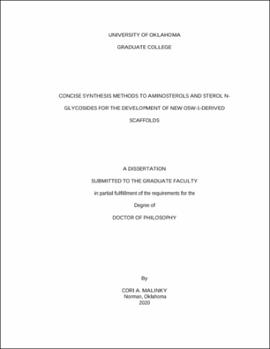| dc.contributor.advisor | Burgett, Anthony | |
| dc.contributor.author | Malinky, Cori | |
| dc.date.accessioned | 2020-05-10T22:06:38Z | |
| dc.date.available | 2020-05-10T22:06:38Z | |
| dc.date.issued | 2020-05-08 | |
| dc.identifier.uri | https://hdl.handle.net/11244/324370 | |
| dc.description.abstract | Abstract
The cholestane glycoside natural product compound OSW-1 has both broad spectrum antiviral activity and potent antiproliferative activity. OSW-1 is a high affinity ligand of both oxysterol-binding protein (OSBP) and OSBP-related protein 4 (ORP4). OSBP has been implicated in viral disease replication, and ORP4 has been shown to play a critical role in cancer cell survival. The synthesis and structural complexity of OSW-1, in combination with its indiscriminate targeting of both OSBP and ORP4, have limited its drug development and the study of its molecular pharmacology. Herein, a new, three-component synthesis approach (i.e. steroid component, side-chain component, and disaccharide component) to produce E-ring azacycle OSW-1-scaffolds was development and pursued. Identification of the new E-ring azacycle OSW-1 scaffold was guided by the development of a putative molecular model of OSW-1 interacting within the oxysterol-binding protein pocket. The new three-component approach to new E-ring azacycle OSW-1-derived scaffolds required the development of two new synthetic methods. The first method required a direct and easily diversified route to 22-aminosterols. A direct, tunable two-component stereoselective formation of either C16-C17-ene-22-aminosterol or 17-hydroxyl-22-aminosterol, using an imino-ene/aza-Prins reaction, was successfully developed. The mechanism of this Lewis acid-mediated imino-ene/aza-Prins reaction was explored. The second new method required for the three-component approach to OSW-1-scaffolds was the development of a novel amine glycosylation method. An atypical application of the Fukuyama-Mitsunobu reaction was successfully developed into an aminosterol N-glycosylation method that affords high yields of coupled 22-aminosterol and the OSW-1 arabinose-xylose-disaccharide. The new reaction methods developed can be generally used to access other aminosterol scaffolds and aminoglycoside carbohydrate-containing compounds. These new methods were used to synthesize a new C-22-aminoglycosylated OSW-1 analog, demonstrating the application of these methods in the synthesis of a complex molecular target. The newly developed methods have laid the fundamental groundwork of the three-component approach to produce E-ring azacyle OSW-1 scaffolds. These new scaffolds will be pursued in the future to rapidly produce new analog compounds for antiviral and anticancer drug development. | en_US |
| dc.subject | Chemistry, Organic. | en_US |
| dc.subject | Chemistry, Biochemistry. | en_US |
| dc.subject | Chemistry, Pharmaceutical. | en_US |
| dc.subject.lcsh | Chemistry, Organic | |
| dc.subject.lcsh | Biochemistry | |
| dc.subject.lcsh | Pharmaceutical chemistry | |
| dc.title | Concise synthesis methods to aminosterols and sterol N-glycosides for the development of new OSW-1-derived scaffolds | en_US |
| dc.contributor.committeeMember | O'Rear, Edgar | |
| dc.contributor.committeeMember | Glatzhofer, Daniel | |
| dc.contributor.committeeMember | Duerfeldt, Adam | |
| dc.contributor.committeeMember | Saparov, Bayrammurad | |
| dc.date.manuscript | 2020-05-08 | |
| dc.thesis.degree | Ph.D. | en_US |
| ou.group | College of Arts and Sciences::Department of Chemistry and Biochemistry | en_US |
| shareok.orcid | https://orcid.org/0000-0003-1828-6759 | en_US |
